The first appointment in the FCI Cynological Days calendar was the canine symposium
held on November 11th entitled
Dog and Man: Quo vadis? Knowledge and perspectives
This challenging questioning was approached by nine speakers who either adopted
a historical perspective or underlined new aspects in our everyday life with dogs.
The first one to take the floor was Yves De Clercq, Executive Director of the FCI,
for a brief introduction of the world’s largest canine organisation. After providing
a few figures and statistics about FCI membership, CACIB shows, titles and registration
of puppies he then informed the audience about what lies behind FCI membership,
both from the breeders’ and the national canine organisations’ standpoint.
© Karl Donvil
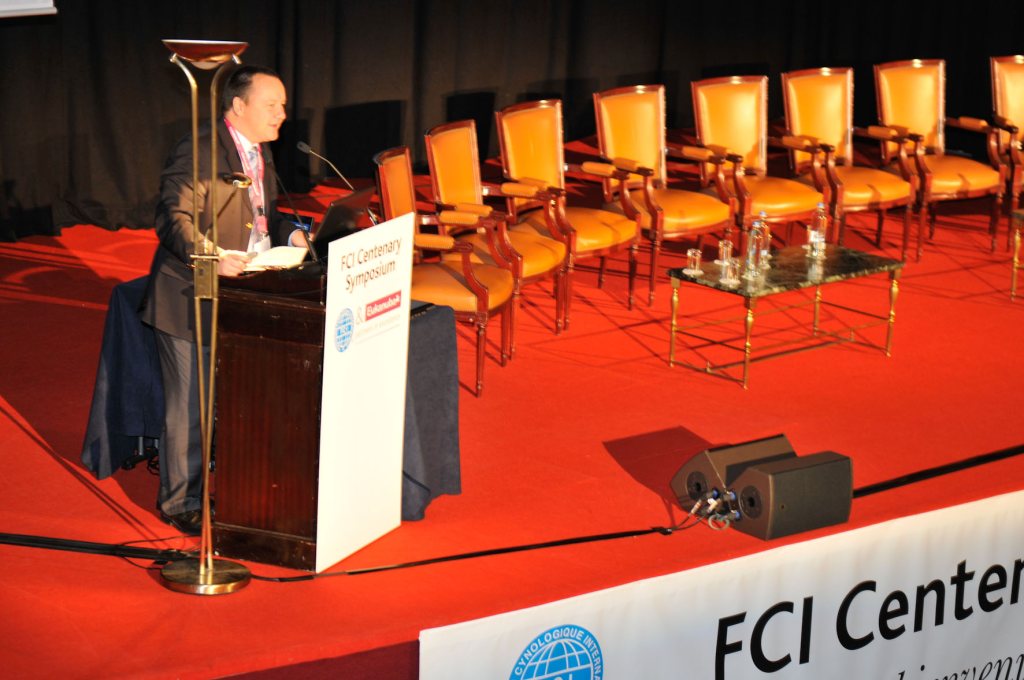

Yves De Clercq (BE), Directeur exécutif de
la FCI depuis 1999.
Prof. Ermanno Maniero followed Mr De Clercq with a rich and fast paced lecture about
the history of the dog. He provided a state-of-the-art overview of the conclusions
reached through studies appealing to, among other, paleontology and paleozoology
regarding its origin and evolution.
© Karl Donvil
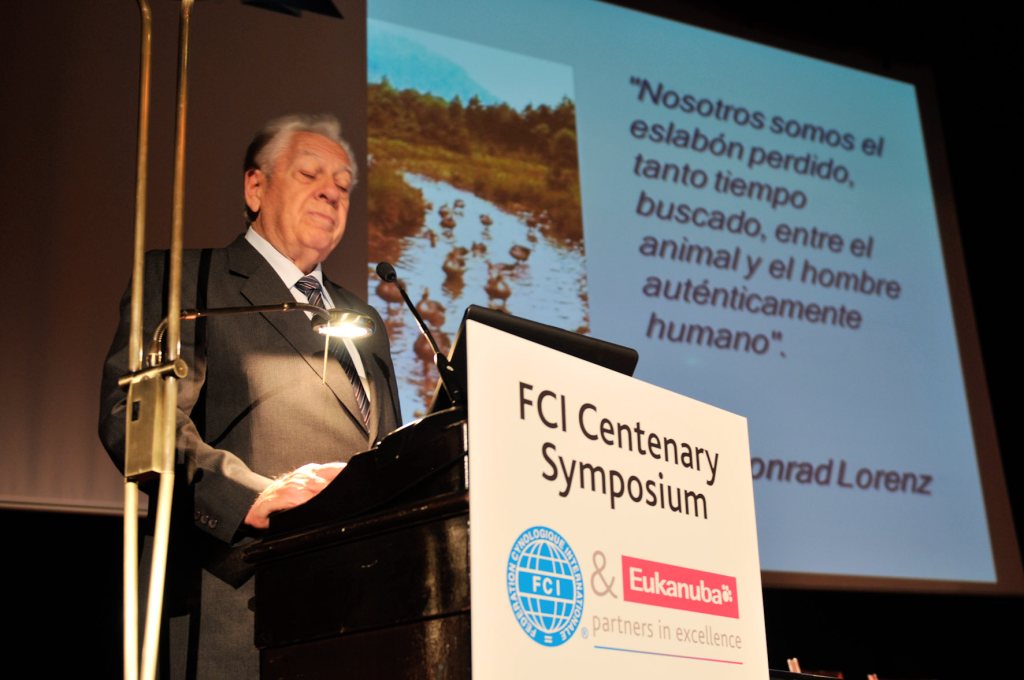

Ermanno Maniero (PE), Chargé de cours
à l'Université de Lima (Pérou).
It was then Dr Göran Bodegård’s turn to tackle the issue of dogs’ health. He started
reminding the audience that the aims of the FCI are “…to encourage and promote the
breeding and use of purebred dogs whose functional health and physical features
meet the standard set for each respective breed and which are able to work and to
carry out different functions in accordance with the specific characteristics of
their breed… to promote and support… dog welfare worldwide…”. In this perspective,
the show judge is in an excellent position to prevent unsound breeding by avoiding
to award dogs of extreme type. He shall guard the characteristics of a breed within
the frames of the standards. Dr. Bodegård presented the project launched by the
Swedish Kennel Club in 2006 in order to prevent the destructive influence on breeding
of extreme-typed dogs fitting the increasing demands of glamorous extremity of the
dog shows. A comprehensive article about this project was published in the 2nd issue
of the FCI Newsletter at
http://newsletter2.dogdotcom.be/en/BSI_SKK.aspx.
© Karl Donvil


Göran Bodegård (SE), MD PhD, Président
du groupe BSI du Kennel Club suédois, Stockholm (Suède).
The morning went on with yet another very interesting lecture by Prof. Erhard Olbrich,
entitled Dogs help to heal. Explaining the social, psychological and somatic effects
of Animal-Assisted Therapy. Neurobiological studies help to explain a large number
of positive effects that have already been observed in Animal-Assisted Therapy for
some considerable time. The basis of these effects lies in the evolutionarily prepared
affinity of humans to their fellow creatures, which Wilson (1984) refers to as biophilia.
Prof. Olbrich provided the audience with lots of illustrations and observations
of this astounding bound between men and dogs.
© Karl Donvil
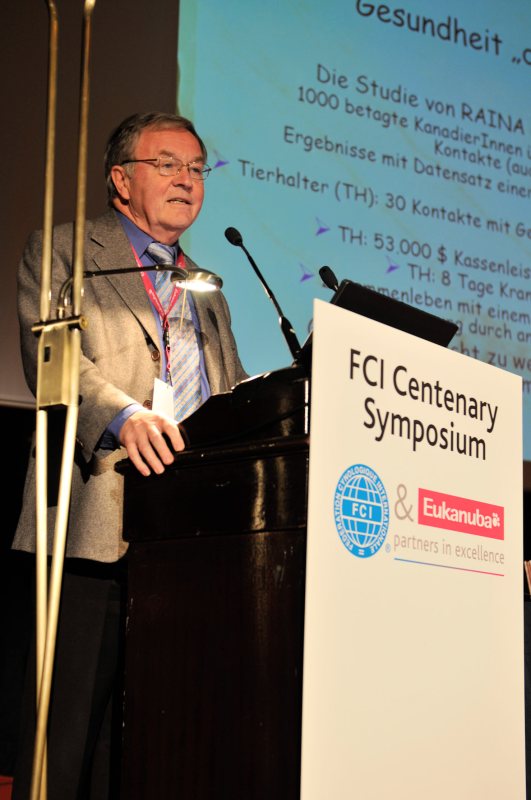

Erhard Olbrich (DE), Professeur émérite
de psychologie à l'Université d'Erlangen-Nürnberg. Président de la Société internationale
pour la Thérapie assistée par l'animal.
We concluded the first part of our symposium with Dr Delphine Clero’s lecture about
Working dog’s functions in society. For centuries, dog has been used by human to
do things he was unable to do by himself. Aware of the fact that some senses, especially
olfaction, are much more developed in dogs than in human beings, the human tries
to teach “his best friend” things which can help him in his everyday life. Almost
everybody knows about the rescue dogs helping to find victims of earthquakes or
avalanches, but does everybody know about dogs being able to warn their owner before
they suffer a hypoglycaemia crisis, or detecting cancer in urine samples?
© Karl Donvil
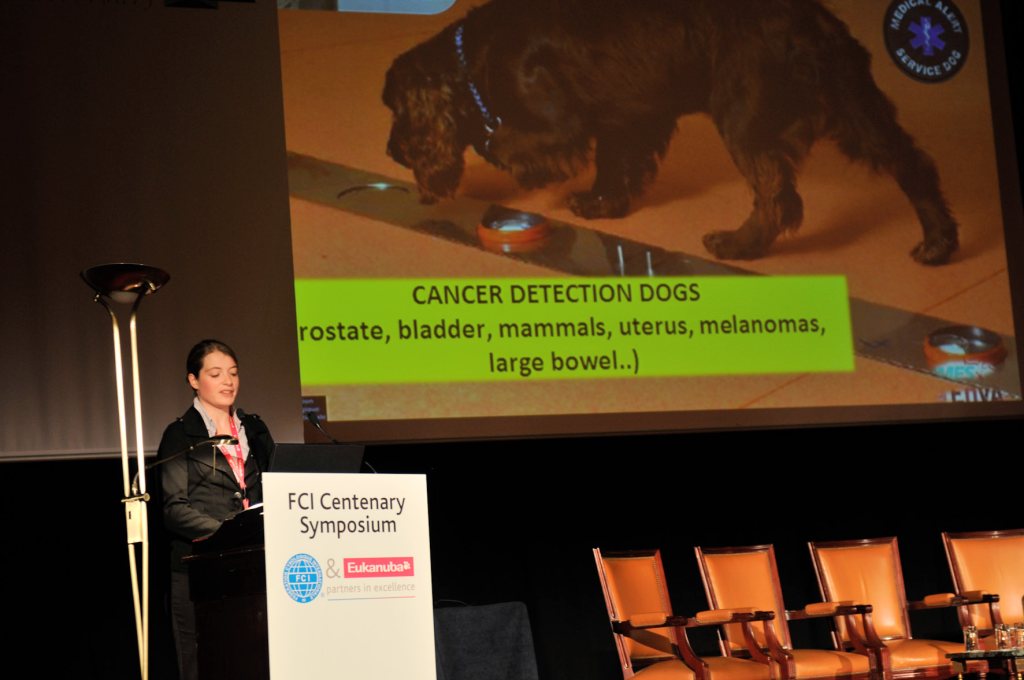

Delphine Clero (FR), Unité de Médecine
de l'Élevage et du Sport, École Nationale Vétérinaire d’Alfort (France).
After a pleasant lunch break, the audience could attend the lecture of Prof Giaovanni
Morsiani about Beauty, temperament and health as fundamental criteria for a correct
selection. What criteria we set for the assessment of dogs is an important question
for judges and breeders in order to help and support the breeds. Should these criteria
emerge from the orientation towards present ideals of beauty or from the dogs currently
to be seen at the shows or should they be shaped on the basis of more general aspects?
Prof. Morsiani led us through his personal album of favourite pieces of art to illustrate
the fundamental principle, set by Heim, which is still valid today: From performance
to type. Beauty, but only with functionality, good health and a controlled nature,
the basis always being the standard.
© FCI


Giovanni Morsiani (IT), Président
de l'Académie technique du Forum international pour le Saint Bernard et professeur
de cynognostique, Université de Bologne (Italie).
After the rather poetic lecture of Mr Morsiani, we had the opportunity to listen
to Dr Fischer’s presentation of his study on dog’s locomotion, which is the largest
carried out on this subject to date. 327 dogs were examined from 32 breeds, the
main question being whether variability can be found in the movement of the different
breeds of dog and, in particular, under the influence of a 40-fold difference in
weight between a Chihuahua or Dachshund and a Mastiff or whether the dogs move in
extensively the same manner irrespective of breed. Contrary to expectations, the
movement of dogs has thus changed only little over the long history of their domestication.
The results of the study were presented in a book entitled “Dogs in motion”, in
which one can also find an extensive portrayal of current knowledge concerning the
locomotion of dogs. The most important results of 300 scientific studies in both
words and pictures were reappraised in such a way that every interested reader can
also obtain extensive information about bones, muscles, joints, as well as overall
motion and the dynamic aspects occurring in this regard. With a unique visual language
presentation and DVD with more than 300 film clips (high-speed videos, high-speed
X-ray films and, in particular, 3D animations), the study opens the door to a new
understanding of the movement of our dogs. A brief presentation of the book could
be found in the 2nd issue of the FCI newsletter
2me édition de la Newsletter de la FCI .
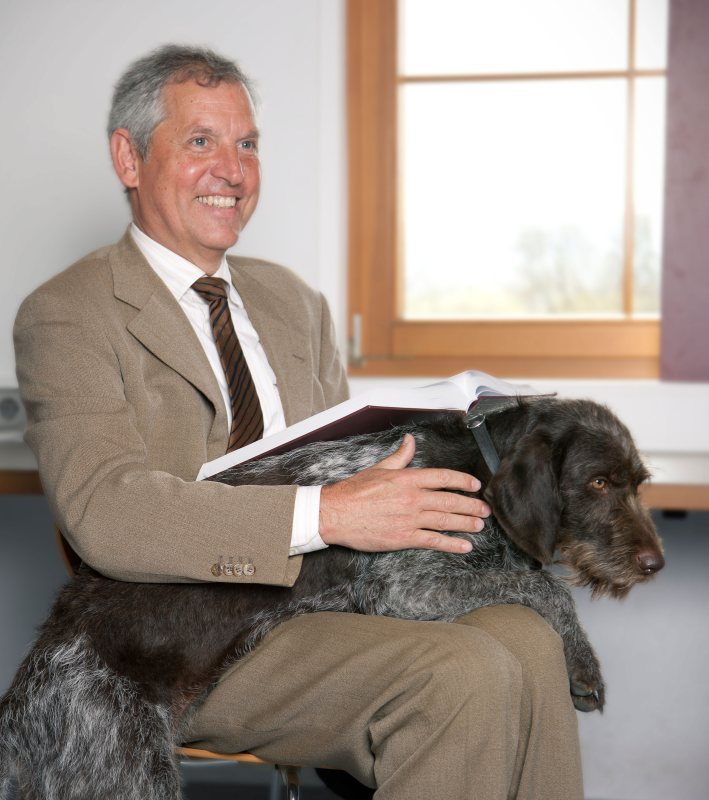

Prof Dr. Martin S. Fischer (DE), Directeur
de l'Institut de zoologie systématique et de biologie de l'évolution avec musée
phylétique.
Around 3 p.m., Mr Meyer took the floor to address a quite stimulating issue: Shows
in the future. It is only right for dog show exhibitors to expect well-organised
shows with appropriate service offerings matching entry fees and reflecting the
associated high financial and time investment. Satisfied exhibitors have become
the basis for successful shows - not just now but also in the future. Future shows
must however be increasingly leveraged as a platform for public relations work focusing
on what we do. If we can take suitable measures and provide the right offerings
to increasingly attract visitors and representatives from the "public at large"
to our events, we need to critically examine the effects our "show circus" and its
processes have on external groups. Mr Meyer suggested several ideas as focusing
on service concepts, on attracting the public at large, luring them with a wide
range of offerings giving them more information on the merits of pedigree dogs,
on keeping dogs in an appropriate manner and on ways of working with dogs. A further
point needing to be looked into is whether new visitors can be attracted by expanding
the thematic scope of shows, for example including pets, horses, leisure or outdoor
activities. His conclusion being that if we all put our heads together, we should
be successful in making future shows not just attractive for exhibitors and breeders
but also for first-time visitors. This does however imply that we put a stop to
negative developments, especially with regard to breeding eccentricities in certain
breeds.
© VDH
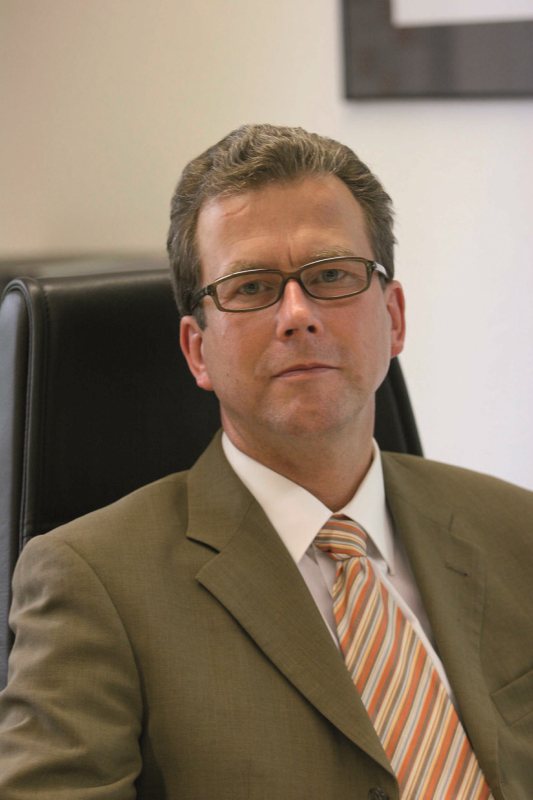

Bernhard Meyer (DE), Directeur exécutif
du VDH (Verband für das Deutsche Hundewesen).
Our last speaker was William Bredal whose lecture entitled Dogs are extraordinary,
feed them accordingly: The importance of science & Nutrition was punctuated by humorous
hints, not only in his words but also in the pictures he had chosen to illustrate
his presentation. In recent years break-through science has resulted in many clinically
documented health benefits in high-quality dog food. These benefits have contributed
substantially to the well-being and longevity of dogs. Through education and clinical
documentation, high-quality dog food producers provide viable alternatives for the
interested dog owner. Unrelenting efforts in canine research and science and the
use of high-quality ingredients, will continue to benefit dogs world-wide.
© Karl Donvil


William Bredal (NO), DVM, P&G Pet care.
This varied range of lectures, all focused on the many roles dogs play in our society,
was followed by a questions-answers session. This session’s moderator was Mr Fred
Denayer - former President of the Belgian Kennel Club -, who had, from the beginning
of the symposium, led the speakers through the tight schedule. He indisputably helped
the lectures to run smoothly and added to their interest by frequent concluding
comments. During the Q/A session, we could appreciate an unscheduled talk by Frank
Comhaire - Professor Emeritus, Universiteit Gent – about Genetic diversity and Inbreeding
- Estimating the level of safe inbreeding of pedigree dogs. The conclusion of the
study he carried out being that it seems possible to estimate coefficient(s) of
inbreeding that correspond(s) to safe/borderline effective population size(s).
© Karl Donvil
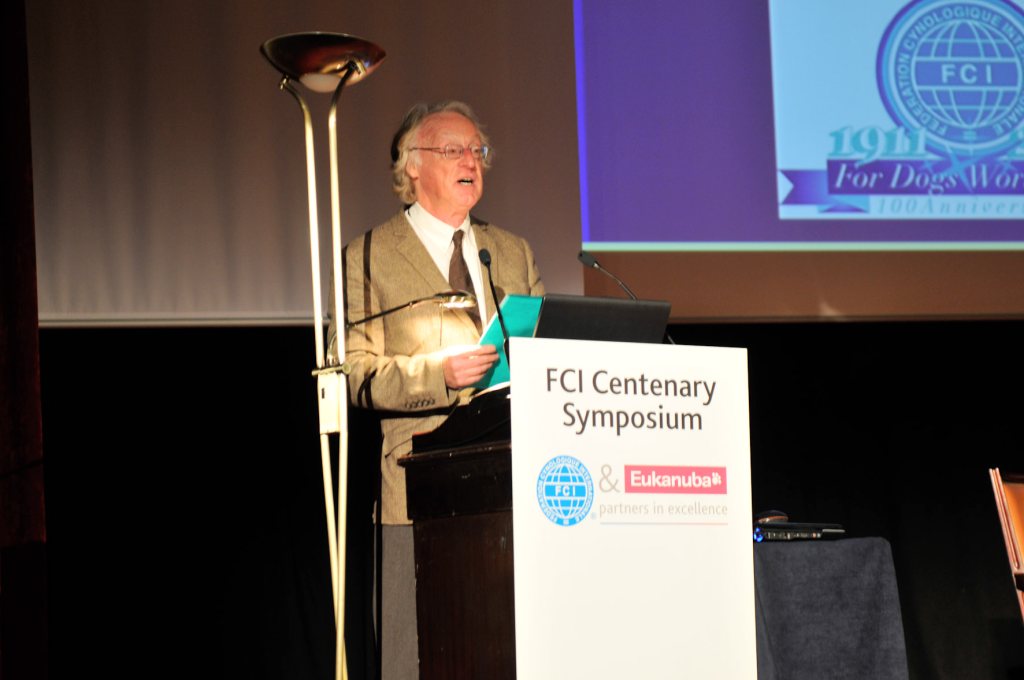

Fred Denayer (BE).
The symposium was opened by José-Luis Ibáñez from Eukanuba, our partner in this
symposium, who declared himself “honoured to be present and to open the symposium”.
Our common concerns about dogs are standards, type, temperament and, of course,
function - since originally dogs were bred to help humans - and our common objectives
are health and well being. Mr Ibáñez then reminded the audience about the signature
of the partnership contract between FCI and Eukanuba in 2006 before declaring what
a great Centenary year 2011 had been for the FCI, reminding us all of its main events:
the FCI Centenary Winner Dog Show in Dortmund, with the launch of Cobby, the FCI
mascot ; the FCI Centenary World Dog Show in Paris, the largest World Dog Show ever
organised, the FCI Centenary European Dog Show in Leeuwarden, « the quality show
», where the FCI and Eukanuba presented the Judging Manual. Mr Ibáñez expressed
his thanks to Mr Müller, the FCI General Committee, Yves De Clercq and Marie Luna
Durán before concluding his opening by quoting Nietzsche “The world was conquered
through the understanding of dogs; the world exists through the understanding of
dogs”, wishing everybody to enjoy this symposium centred around the understanding
of dogs.
© Karl Donvil
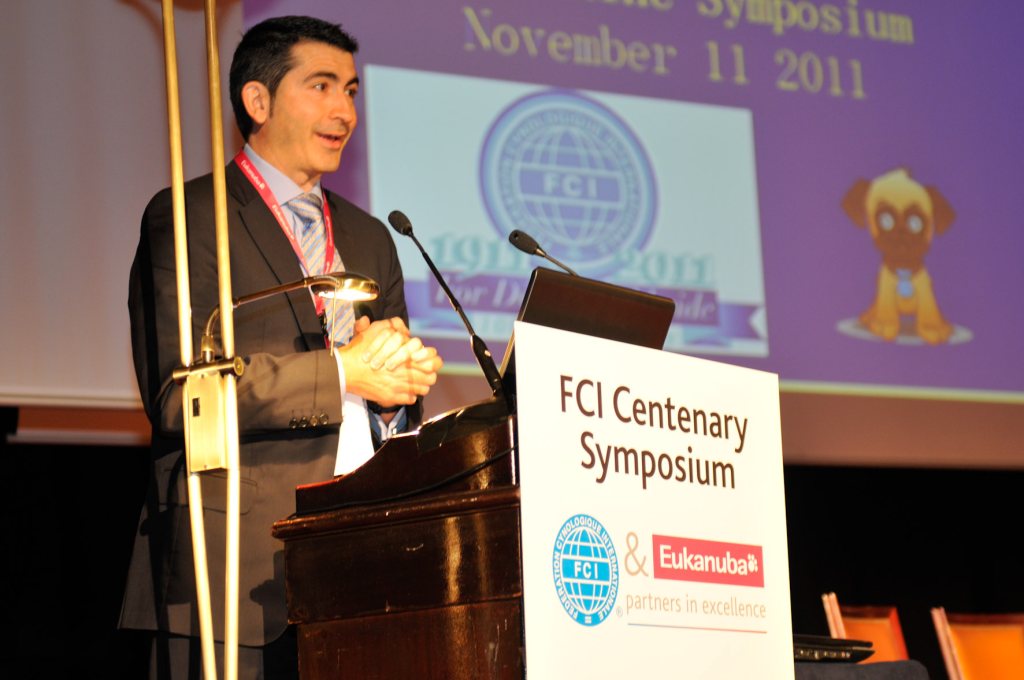

José-Luis Ibañez (ES), EMEA influencer MS&P
We were also very honoured to welcome the delegates from several institutions working
for the welfare of animals like Mrs Marlene Wartenberg (FOUR PAWS), Mrs Ulrike Tewes
(FECAVA). Mr Walter Lodewyckx and Mrs Leen Versmissen (Consortium Problématique
de l’Elevage des Chiens - Région Flamande).
The venue - the Moorish style theatre of the Brussels hotel Le Plaza – was not only
spectacular but also perfectly fit for such an event, which attracted 140 participants:
FCI members representatives, international dog press delegates, general public,
agents from institutions active in the field of animal welfare,…
© Karl Donvil 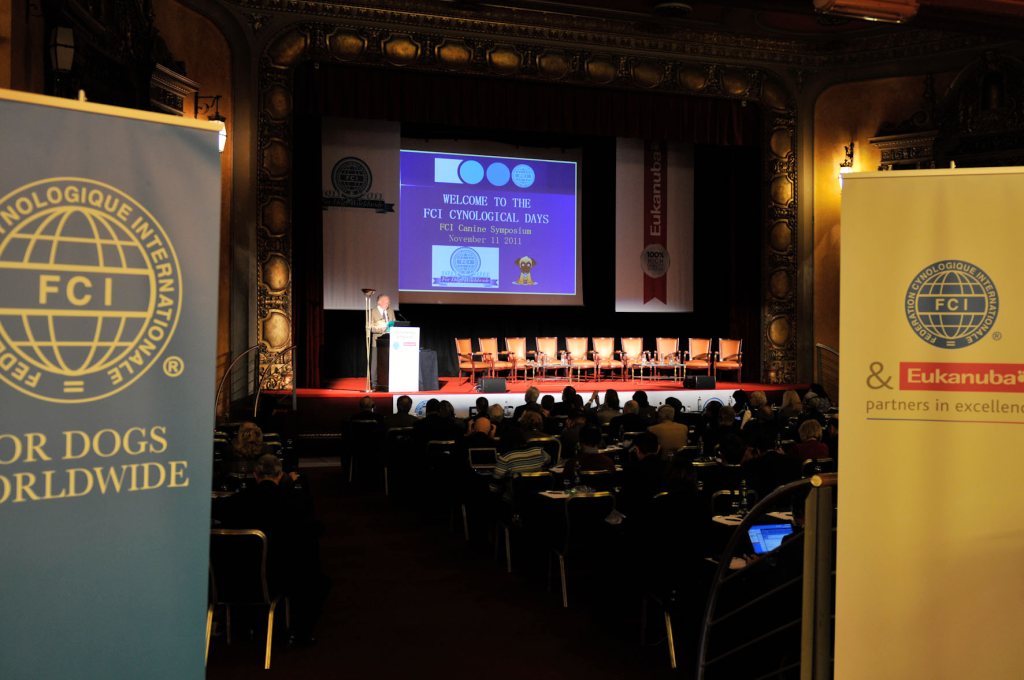 |
© Karl Donvil 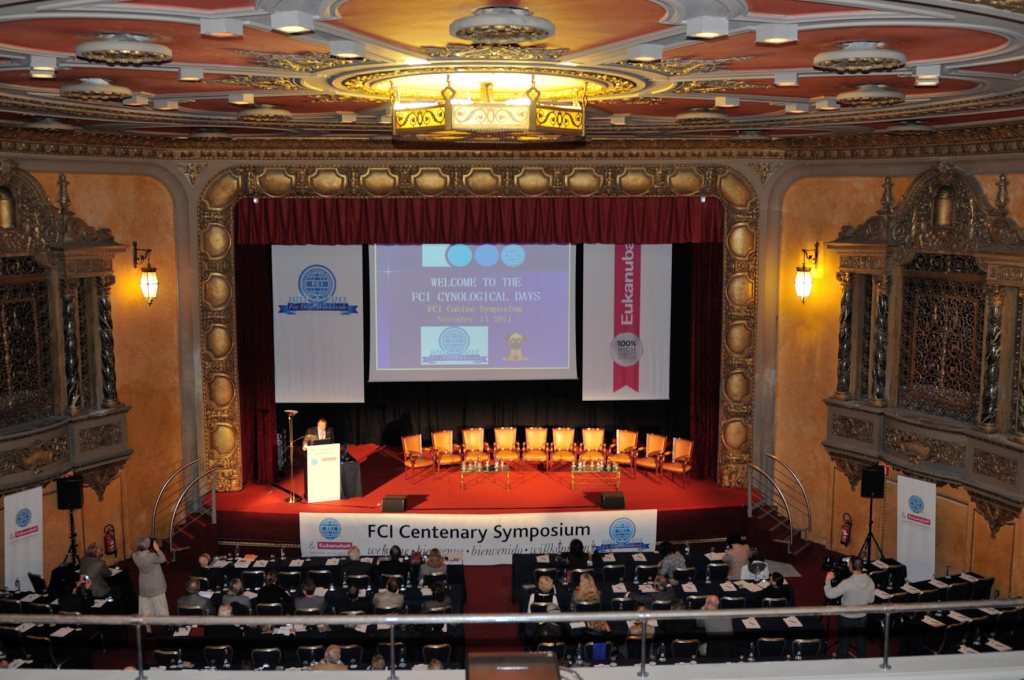 |
© Karl Donvil 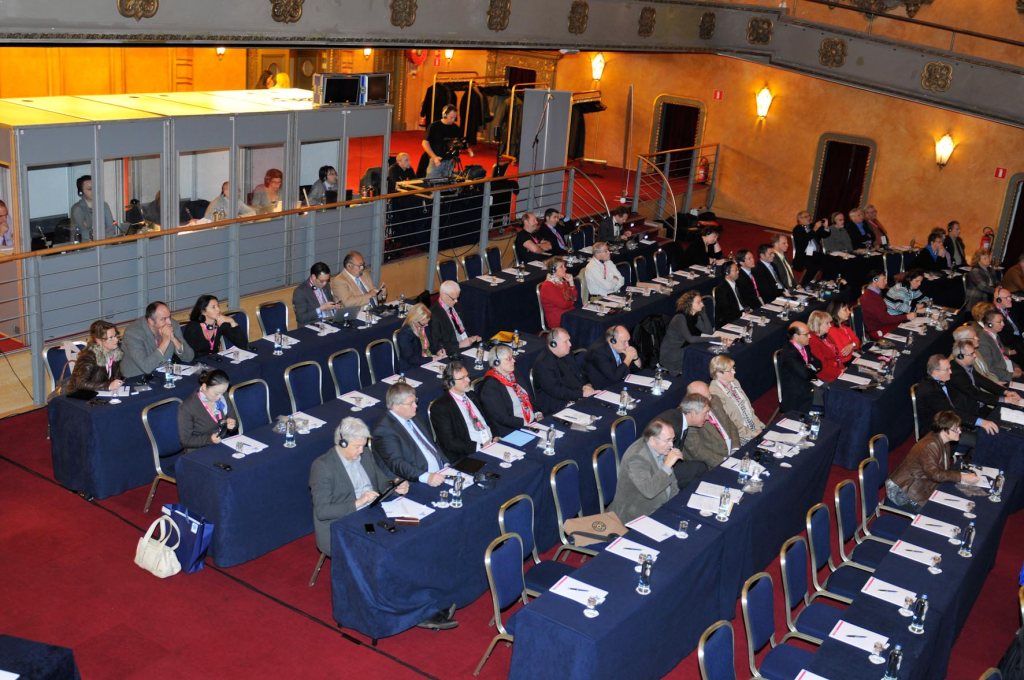 |
© Karl Donvil 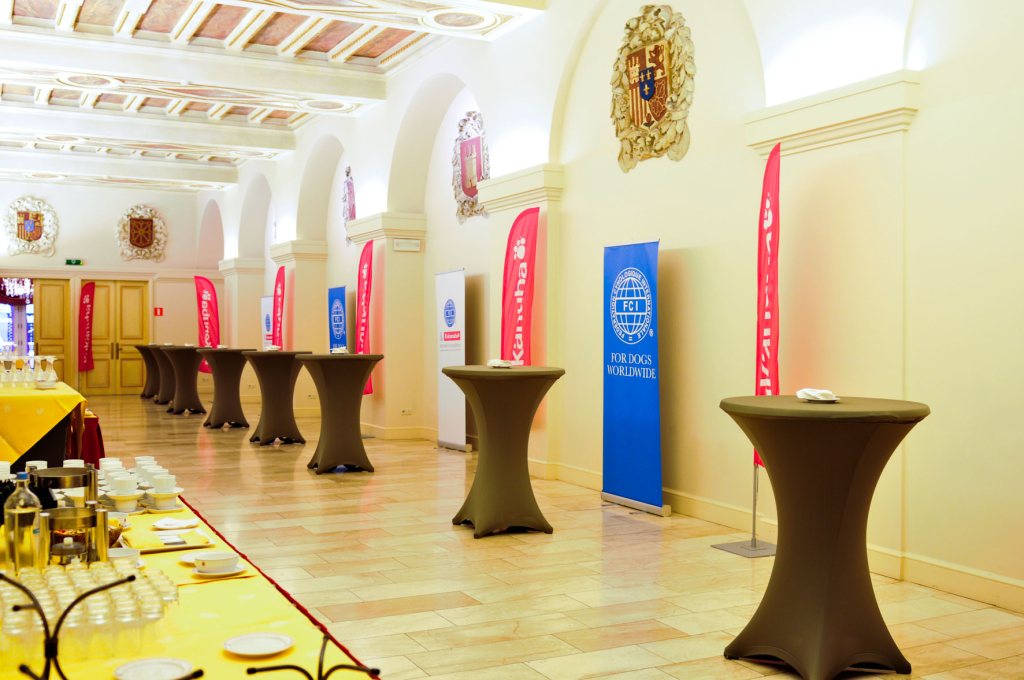 |
The symposium was recorded by a team appointed by the FCI. Excerpts will be broadcast
at
www.fci.be
and made available through several media in due time. If you are interested in receiving
a copy of the proceedings, please contact
.
Marie Luna Durán,
FCI Marketing & Public Relations Manager
